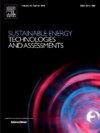From environmental invasive weeds to solid biofuels: assessing bioenergy potential through pelletisation and operational optimisation
IF 7
2区 工程技术
Q1 ENERGY & FUELS
Sustainable Energy Technologies and Assessments
Pub Date : 2025-06-10
DOI:10.1016/j.seta.2025.104396
引用次数: 0
Abstract
Global moves towards net-zero emissions have led to rising demand for renewable solid bioenergy, including biomass pellets. Invasive environmental weeds (IEW) represent an underutilised biomass stream that can be diverted from landfills and repurposed as fuel. This study examines the potential of converting IEW into market-grade pellets. Fifteen weed species (woody and non-woody) were characterised for lignocellulosic composition, ash content, and elemental profiles. Pellets were produced under varied temperature (25–100 °C) and pressure (50–150 bar) conditions. Key indicators of quality (durability, unit density, ash content, and calorific value) were assessed against industry standards (ISO 17,225 and ENplus®). Non-woody species such as Brazilian Nightshade and Climbing Asparagus, containing about 24 % lignin, produced durable pellets (97–98 %) with high energy density (up to 3.9 GJ/m3) and low ash (<5.1 %). Some species (e.g., Singapore Daisy, Mexican Ruellia) had elevated ash and problematic elements (K, Na, S). Response surface modelling revealed optimal pelleting parameters, while principal component analysis underscored lignin content, ash chemistry, and particle size distribution as factors influencing pellet performance. Results show that, with suitable processing, IEW can be valorised for bioenergy. Future work should address ash-related challenges via co-pelleting or additives to facilitate large-scale uptake and contribute to net-zero targets.

从环境入侵杂草到固体生物燃料:通过颗粒化和操作优化评估生物能源潜力
全球向净零排放的转变导致对可再生固体生物能源的需求不断增加,包括生物质颗粒。入侵环境杂草(IEW)代表了一种未充分利用的生物质流,可以从垃圾填埋场转移并重新用作燃料。本研究探讨了将IEW转化为市场级颗粒的潜力。对15种杂草(木本和非木本)的木质纤维素组成、灰分含量和元素分布进行了表征。在不同的温度(25-100°C)和压力(50-150 bar)条件下生产球团。关键质量指标(耐久性、单位密度、灰分含量和热值)根据行业标准(ISO 17225和ENplus®)进行评估。非木本植物,如巴西龙葵和攀爬芦笋,含有约24%的木质素,生产耐用的颗粒(97 - 98%)具有高能量密度(高达3.9 GJ/m3)和低灰分(< 5.1%)。一些品种(如新加坡雏菊、墨西哥Ruellia)的灰分和问题元素(K、Na、S)含量较高。响应面模型揭示了最佳造球参数,而主成分分析强调木质素含量、灰分化学和粒径分布是影响造球性能的因素。结果表明,通过适当的处理,IEW可以用于生物能源。未来的工作应通过共制球或添加剂来解决与灰有关的挑战,以促进大规模吸收并为实现净零目标做出贡献。
本文章由计算机程序翻译,如有差异,请以英文原文为准。
求助全文
约1分钟内获得全文
求助全文
来源期刊

Sustainable Energy Technologies and Assessments
Energy-Renewable Energy, Sustainability and the Environment
CiteScore
12.70
自引率
12.50%
发文量
1091
期刊介绍:
Encouraging a transition to a sustainable energy future is imperative for our world. Technologies that enable this shift in various sectors like transportation, heating, and power systems are of utmost importance. Sustainable Energy Technologies and Assessments welcomes papers focusing on a range of aspects and levels of technological advancements in energy generation and utilization. The aim is to reduce the negative environmental impact associated with energy production and consumption, spanning from laboratory experiments to real-world applications in the commercial sector.
 求助内容:
求助内容: 应助结果提醒方式:
应助结果提醒方式:


